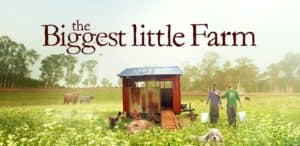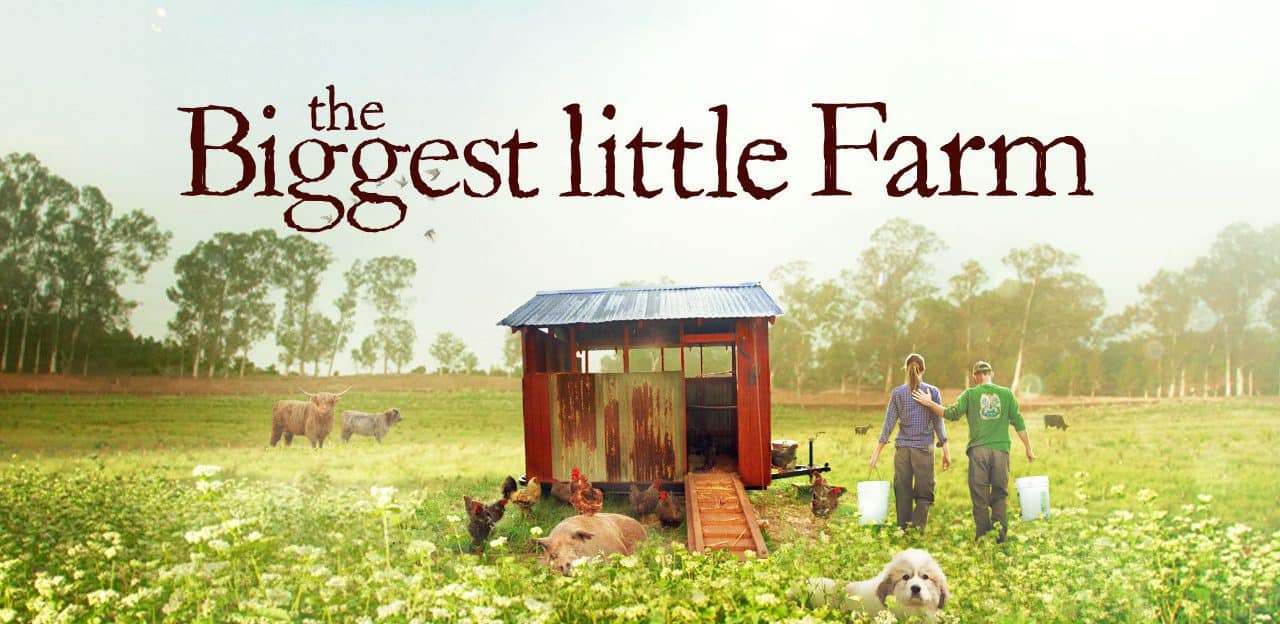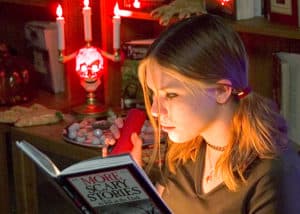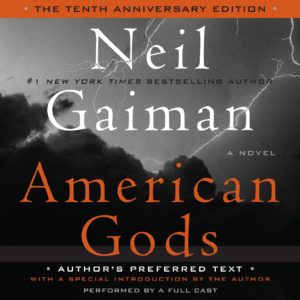 I stumbled upon this year’s must-see documentary, The Biggest Little Farm. Perhaps it was a teaser trailer online or a review I read somewhere. I’m a documentary enthusiast, so I was more than thrilled to find the award-winning gem.
I stumbled upon this year’s must-see documentary, The Biggest Little Farm. Perhaps it was a teaser trailer online or a review I read somewhere. I’m a documentary enthusiast, so I was more than thrilled to find the award-winning gem.
I instantly fell for the story of Apricot Lane Farm. The documentary begins with hand-drawn animation – John and Molly and their marriage, hopes and dreams that actually revolved around their annoying yet lovable blue-eyed dog, Todd. Their love of Todd, a rescue who would not stop barking when he was left alone, reminded me of the love I’ve had for my own dogs. It didn’t surprise me at all, as the documentary started, that John and Molly chose to move away from Los Angeles and purchase a farm so that Todd could be with them all day long.
John and Molly found a 213-acre farm only 40 miles north of LA for sale and purchased it with help from a family investor. Initial video footage in the documentary reveals a dry and barren wasteland with abandoned beehives, unproductive land, and fruitless and dying trees. With the advice of a farming mentor, the miracle of nature, and their absolute perseverance, Molly and John built Apricot Lane Farm into a thriving, biodynamic business. The film’s cinematography takes your breath away. The captivating animals break or sooth your heart. Yet it’s the documentary’s clear messages: heed Mother Nature, work with the land, and be patient – that will inspire everyone.
John Chester was raised in a family living near Ocean City, Maryland. They taught him that every endeavor was possible. He was a videography geek in high school, filming news for local cable access and producing short films. His enthusiasm and passion led to a move across the country to the west coast and Los Angeles. His popular series, Random 1, was seen on the A&E channel. Fans adored the show, but it was canceled after just one season. One particular episode was made into a feature film, Lost in Woonsocket. I’ll get to that significance later.
When John and Molly met, and married, and then rescued Todd-the-dog, Molly was a personal chef in the Los Angeles area. She had an inclination and talent for using unusual and farm-fresh ingredients to create meals for her customers in their homes.
The couple tried everything to stop Todd from barking, even using a citronella collar that caused their apartment, and Todd, to reek at the end of the day. Coming from an abusive environment in a pet hoarder’s home, their four-footed friend anxiously missed them. The family of three was soon evicted. That led to the immediate end of Los Angeles and apartment living. A new beginning on the farm included hundreds of animals besides Todd: sheep herding dogs and sheep, horses, cows, ducks, chickens, and one lovely pig.
John’s 20 years of experience in film-making played a significant role in the farm’s story. The premise behind Random 1 was that John, his partner Andre Miller, and the crew behind the scenes would search for and find one person who needed help to turn his/her life around. There were strict rules for the filmmakers to follow: no money could be given or spent, the person helped had to be a stranger to them, and the mission to help must be completed within 24 hours.
John and Andre broke the rule in Episode 4 in the fall of 2005, when they found two men living in the woods in Woonsocket, Rhode Island. John’s and Andre’s compassion could not leave the two severe alcoholics living in such desperate squalor. Over several months, both men were given chances to recover and actually reunite with their parents or children who had not seen them in years. The documentary, Lost in Woonsocket, is a profound and hopeful story, and it is now in our library’s collection. Updates to the story can be found online.
It is John’s empathy for fellow humans that translates to his rescued dog, Todd, and to the animals on Apricot Lane Farm. Spending a night with his nearly-dying hog, Emma, is just one of the many moments that are inspirational in The Biggest Little Farm. And those moments convinced John and Molly to persevere through years of uncovering the secrets, mysteries, conflicts, and successes of organic and biodynamic farming.
No one really knew that nearly 8 years of filming from 2011-2018 would lead to such an inspirational film. John didn’t actually tell many people about his idea to knit the video clips into a documentary about their farm. He didn’t actually know until at least six years in whether the farm would be a failure or a success. Viewing film clips after five or six years on the farm made him realize that he had actually been a pessimist and that it was his wife Molly’s never-ending belief and trust that got them through.
The Chesters had a crew of hundreds supporting and working with them over the years, both farm-workers and interns. However, it was one person, Alan York, who was their muse right from the start. Molly had researched farming experts and found York, an agricultural savant who taught them how to create and design a biodiverse, working farm. He taught them that nature, the land, the seasons, and animals work in a natural rhythm. What they learned from him, above all, was that Mother Nature is on her own time schedule. The challenges of weather, predators, and infestations hit them head-on, and Alan saw them through those first tough years. Snails, birds, and ladybugs Biblically rained upon them. Coyotes, wildfires, drought and rains threatened from all sides. It was Alan York who taught them to plant more grass for the sheep, to efficiently collect more water in their aquifers, and to collect their animal droppings to enrich the soil. Unfortunately, York died of pancreatic cancer in 2014. But his lessons stayed with Molly and John, and the land began to give back in miraculous ways.
John Chester wants everyone to watch The Biggest Little Farm, even children. He’s written a children’s book about his pig; Saving Emma the Pig was published this year. In an interview with his hometown news, The Ocean City Dispatch, John insists that it is children over the years who have saved our world – through convincing us to recycle, to wear our seat-belts, to stop smoking. Seven-year-olds, third graders, “are going to shape the world we live in. When they see something, and they believe it, and they see opportunity in that, then they make us, as parents, do things.”
If you want to be inspired, check out John Chester’s The Biggest Little Farm and Lost in Woonsocket from our library. They are both foods for the soul.
Charlotte Canelli is the Director of the Morrill Memorial Library in Norwood, MA. Look for her article in the November 7th edition of the Transcript and Bulletin.



